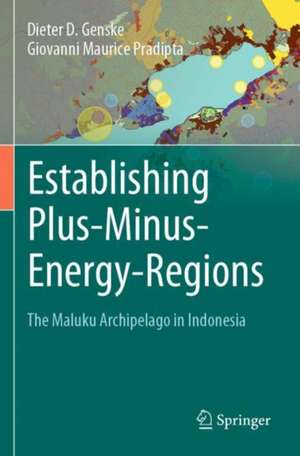Establishing Plus-Minus-Energy-Regions: The Maluku Archipelago in Indonesia
Autor Dieter D. Genske, Giovanni Maurice Pradiptaen Limba Engleză Paperback – 2 feb 2023
Based on the research presented in this book, it is clear that the archipelago has the potential to become a so-called plus-minus region. Plus-minus regions are regions that produce more renewable energy than they need and capture more CO2 than they emit.
The authors are convinced that the presented strategy illustrated on the Maluku Archipelago can be transferred to other regions of the world and that only by developing plus-minus regions the international 2°C climate goal can be achieved. The model region thus serves as proof that the plus-minus target can also be achieved in emerging countries with limited financial resources.
Toate formatele și edițiile
| Toate formatele și edițiile | Preț | Express |
|---|---|---|
| Paperback (1) | 635.65 lei 6-8 săpt. | |
| Springer International Publishing – 2 feb 2023 | 635.65 lei 6-8 săpt. | |
| Hardback (1) | 891.33 lei 6-8 săpt. | |
| Springer International Publishing – feb 2022 | 891.33 lei 6-8 săpt. |
Preț: 635.65 lei
Preț vechi: 747.82 lei
-15% Nou
Puncte Express: 953
Preț estimativ în valută:
121.66€ • 131.32$ • 102.01£
121.66€ • 131.32$ • 102.01£
Carte tipărită la comandă
Livrare economică 18 aprilie-02 mai
Preluare comenzi: 021 569.72.76
Specificații
ISBN-13: 9783030935986
ISBN-10: 3030935981
Pagini: 166
Ilustrații: XXIX, 166 p. 64 illus., 60 illus. in color.
Dimensiuni: 155 x 235 x 14 mm
Greutate: 0.29 kg
Ediția:1st ed. 2022
Editura: Springer International Publishing
Colecția Springer
Locul publicării:Cham, Switzerland
ISBN-10: 3030935981
Pagini: 166
Ilustrații: XXIX, 166 p. 64 illus., 60 illus. in color.
Dimensiuni: 155 x 235 x 14 mm
Greutate: 0.29 kg
Ediția:1st ed. 2022
Editura: Springer International Publishing
Colecția Springer
Locul publicării:Cham, Switzerland
Cuprins
Time is running out.- Why there is no time left.- City, Urbanization, and Energy.- City, Urbanization, and Energy.- Energy Footprints, the Intra Muros-Principle and Plus-Minus-Regions.- The Space-Resources Principle.- The Spatial-Prototype Principle.- The Principle of Closing Loops.
Textul de pe ultima copertă
This book explains and illustrates how Indonesia as the largest and most populous country in Southeast Asia can become independent of fossil fuels by both reducing its energy needs and using renewable resources. A study presented in this work focuses on the Maluku Archipelago in eastern Indonesia with Ambon as its capital. Conventional energy is brought to the islands over long distances by partly simple means as boats, ships and aircrafts. This unsustainable situation calls for a decentralized renewable energy supply strategy.
Based on the research presented in this book, it is clear that the archipelago has the potential to become a so-called plus-minus region. Plus-minus regions are regions that produce more renewable energy than they need and capture more CO2 than they emit.
The authors are convinced that the presented strategy illustrated on the Maluku Archipelago can be transferred to other regions of the world and that only by developing plus-minus regions the international 2°C climate goal can be achieved. The model region thus serves as proof that the plus-minus target can also be achieved in emerging countries with limited financial resources.
Based on the research presented in this book, it is clear that the archipelago has the potential to become a so-called plus-minus region. Plus-minus regions are regions that produce more renewable energy than they need and capture more CO2 than they emit.
The authors are convinced that the presented strategy illustrated on the Maluku Archipelago can be transferred to other regions of the world and that only by developing plus-minus regions the international 2°C climate goal can be achieved. The model region thus serves as proof that the plus-minus target can also be achieved in emerging countries with limited financial resources.
Caracteristici
Provides a simple, proven, and transferable strategy to decarbonize regions Is well and richly illustrated with maps and diagrams Covers step-by-step procedure to reduce fossil dependence and CO2 emission
